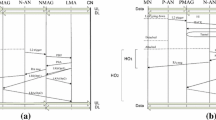Abstract
In the future cloud computing, users will heavily use mobile devices. Mobile networks for cloud computing should be managed efficiently as well as support seamless services to mobile users regardless of their locations and movements. Hence, in mobile networks for cloud computing, it is important to support seamless mobility management to mobile users who request real-time services such as VoIP, streaming, and interactive game playing. To support seamless mobility management for various wireless technologies in cloud computing, Mobile IPv6 (MIPv6) and fast handovers for MIPv6 (FMIPv6) have been studied. FMIPv6 has been emerged to reduce long handover latency and packet loss in MIPv6. FMIPv6 may provide seamless handover by minimizing the handover latency, and prevent packet loss through buffering and tunneling. FMIPv6 uses anticipation based on layer 2 trigger information, and consists of two operation modes such as the predictive mode and the reactive mode. Several works have been done to evaluate the performance of FMIPv6 in different network environments. However, the previous works did not consider the probability of predictive mode failure (PPMF) that distinguishes two operation modes. Even in the most previous work, two operation modes of FMIPv6 are evaluated separately. However, to accurately analyze the overall performance of FMIPv6, two operation modes should be analyzed altogether. In this paper, FMIPv6 combining two operation modes is analyzed considering the PPMF that is affected by the radius of a cell, velocity of mobile nodes, and the layer 2 triggering time. The effect of system parameters, such as the PPMF, the time required to process additional layer 3 signaling, and the layer 2 trigger time, is analytically investigated with respect to the signaling cost and the packet delivery cost. Analytical results show a trade-off between performance and system parameters. Then we show methods to optimize overhead of FMIPv6. Finally, mobile networks for cloud computing can be efficiently managed through the optimized FMIPv6.
Similar content being viewed by others
References
Wei G, Vailakos A-V, Zheng Y, Xiong N (2009) A game-theoretic method of fair resource allocation for cloud computing services. J Supercomput. doi:10.1007/s11227-009-0318-1
Dikaiakos M-D, Pallis G, Katsaros D, Mehra P, Vakali A (2009) Cloud computing: distributed Internet computing for IT and scientific research. IEEE Internet Comput 13(5):10–13
Abu-Tair M, Min G, Ni Q, Liu H (2009) An adaptive medium access control scheme for mobile ad hoc networks under self-similar traffic. J Supercomput. doi:10.1007/s11227-009-0324-3
Li C, Li L (2009) Tradeoffs between energy consumption and QoS in mobile grid. J Supercomput. doi:10.1007/s11227-009-0330-5
Cherry S (2009) Forecast for cloud computing: up, up, and away. IEEE Spectrum 46(10):68
Kruys J (2009) Untethered clouds. IEEE Wirel Commun 16(4):8–10
Golmie N (2009) Seamless mobility: are we there yet? IEEE Wirel Commun 16(4):12–13
Johnson D, Perkins C, Arkko J (2004) Mobility support in IPv6. IETF, RFC 3775
Koodli R (ed) (2005) Fast handovers for Mobile IPv6. IETF RFC 4068
Perez-Costa X, Torrent-Moreno M, Hartenstein H (2003) A performance comparison of Mobile IPv6, hierarchical Mobile IPv6, fast handovers for Mobile IPv6 and their combination. ACM Mobile Comput Commun Rev 7(4):5–19
Gwon Y, Kempf J, Yegin A (2004) Scalability and robustness analysis of Mobile IPv6, fast Mobile IPv6, hierarchical Mobile IPv6, and hybrid IPv6 mobility protocols using a large-scale simulation. In: Proc IEEE int conf on commun (ICC’04), vol 7, pp 4087–4091
Li R, Li J, Wu K, Xiao Y, Xie J (2008) An enhanced fast handover with low latency for Mobile IPv6. IEEE Trans Wirel Commun 7(1):334–342
Fathi H, Chakraborty S, Prasad R (2007) Optimization of Mobile IPv6-based handovers to support VoIP services in wireless heterogeneous networks. IEEE Trans Veh Technol 56(1):260–270
Pack S, Choi Y (2003) Performance analysis of fast handover in Mobile IPv6 networks. In: Proc LNCS, vol 2775, pp 679–691
Makaya C, Pierre S (2008) An analytical framework for performance evaluation of IPv6-based mobility management protocols. IEEE Trans Wirel Commun 7(3):972–983
Ho J-S-M, Akyildiz I-F (1995) Mobile user location update and paging under delay constraints. ACM-Baltzer J Wirel Netw 1:413–425
Akyildiz I-F, Wang W (2002) A dynamic location management scheme for next-generation multitier PCS systems. IEEE Trans Wirel Commun 1(1):178–189
Markoulidakis J, Lyberopoulos G, Anagnostou M (1998) Traffic model for third generation cellular mobile telecommunications systems. ACM-Baltzer J Wirel Netw 4:389–400
Wan G, Lin E (1999) Cost reduction in location management using semi-realtime movement information. ACM-Baltzer J Wirel Netw 5:245–256
Lin Y-B (1997) Modeling techniques for large-scale PCS networks. IEEE Commun Mag 35(2):102–107
McNair J, Akyildiz I-F, Bender MD (2000) An inter-system handoff technique for the IMT-2000 system. In: Proc IEEE INFOCOM, pp 208–216
McNair J, Akyildiz I-F, Bender MD (2001) Handoffs for real-time traffic in Mobile IP version 6 networks. In: Proc IEEE GLOBECOM, vol 6, pp 3463–3467
Xie J, Akyildiz I-F (2002) A novel distributed dynamic location management scheme for minimizing signaling costs in Mobile IP. IEEE Trans Mobile Comput 1(3):163–175
Lai WK, Chiu J.C (2005) Improving handoff performance in wireless overlay networks by switching between two-layer IPv6 and one-layer IPv6 addressing. IEEE J Sel Areas Commun 23(11):2129–2137
Author information
Authors and Affiliations
Corresponding author
Rights and permissions
About this article
Cite this article
Ryu, S., Lee, K. & Mun, Y. Optimized fast handover scheme in Mobile IPv6 networks to support mobile users for cloud computing. J Supercomput 59, 658–675 (2012). https://doi.org/10.1007/s11227-010-0459-2
Published:
Issue Date:
DOI: https://doi.org/10.1007/s11227-010-0459-2




